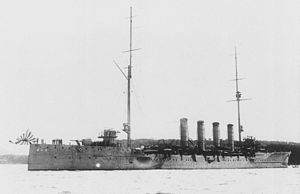- Chikuma class cruiser
-

Chikuma during commissioning, 1912Class overview Name: Chikuma-class cruiser Operators:  Imperial Japanese Navy
Imperial Japanese NavyPreceded by: Japanese cruiser Tone Succeeded by: Tenryu-class cruiser Completed: 3 ordered,
3 laid down,
3 commissionedGeneral characteristics Type: Protected cruiser Displacement: 5,000 long tons (5,080 t) Length: 134.1 m (440 ft 0 in) Beam: 14.2 m (46 ft 7 in) Draught: 5.1 m (16 ft 9 in) Propulsion: Two Shaft Curtiss Turbine Engines; 16 boilers;
22,500 hp (16,800 kW)Speed: 26 knots (30 mph; 48 km/h) Range: 10,000 nmi (19,000 km) at 10 kn (12 mph; 19 km/h) Armament: • 8 × 152 mm (6 in) guns
• 4 × 80 mm (3 in) guns
• 2 × machine guns
• 3 × 450 mm (18 in) torpedo tubesArmour: Deck: 22 mm (0.87 in) to 57 mm (2.2 in)
Conning tower: 102 mm (4.0 in)[1]The three Chikuma-class cruisers (筑摩型防護巡洋艦 Chikuma-gata bōgojun'yōkan) were second class protected cruisers operated by the Imperial Japanese Navy. They participated in numerous actions during World War I.
The Chikuma-class was the final class of protected cruiser in the Imperial Japanese Navy, and was followed by the Tenryu-class of light cruisers.
Contents
Background
The Chikuma-class light cruisers were built as part of the 1907 Naval Expansion Program, based on lessons learned during the Russo-Japanese War. Along with the Kongo-class battlecruisers, the Chikuma-class was part of a project to build a high speed navy based on the latest naval technologies.
Design
The basic design of the Chikuma-class cruisers was modeled after the British Town-class with some modifications and was also largely influenced by the design of the Tone. The Chikuma-class cruisers were the first high-speed turbine-driven cruisers in the Imperial Japanese Navy, which gave them much greater speed than previous cruiser designs. The silhouette of the Chikuma-class was readily distinguishable due to its four smokestacks. Contrary to many popular publications, the protection of the Chikuma-class was similar to Tone-class, and they remained protected cruisers, without an armoured belt.[1]
Chikuma and Hirado used the newly-developed Curtiss turbines, which gave them a rated top speed of 26 knots. During speed trials, they achieved 26.83 and 26.87 knots respectively. Yahagi was built with a Parsons-type turbine engine, and achieved 27.14 knots during speed trials.
In terms of armaments, the Chikuma-class was unique in its use of single caliber main batteries, which it carried as well as eight six-inch guns and two three-inch guns.[2]
Ships in class
Three ships were budgeted for and completed under the 1907 Naval Expansion Program, one each from the Sasebo Navy Yard, Mitsubishi, Nagasaki and Kawasaki, Kobe. All served in World War I and were scrapped before the start of World War II
Launched on 1 April 1911 and completed on 17 May 1912 by the Sasebo Navy Yard, Chikuma participated in various operations in World War I in the central and southern Pacific Ocean. It was stricken on 1 April 1931, and expended as a target in 1935.
Launched on 3 October 1911 and completed on 27 July 1912 by the Mitsubishi Nagasaki shipyards, Yahagi participated in various operations in World War I in the Pacific Ocean and Indian Ocean. It was later used during the Siberian Intervention and the opening stages of the Second Sino-Japanese War. It was stricken on 1 April 1940, its hulk serving as a barracks until 1943.
Launched on 29 June 1911 and completed on 17 June 1912 by the Kawasaki, Kobe Shipyards, Hirado participated in various operations in World War I in the central and southern Pacific Ocean. It was later used during the Siberian Intervention and the opening stages of the Second Sino-Japanese War. It was stricken on 1 April 1940, its hulk serving as a barracks until 1943.
See also
 Media related to Chikuma class protected cruisers at Wikimedia Commons
Media related to Chikuma class protected cruisers at Wikimedia CommonsReferences
Books
- Evans, David (1979). Kaigun : Strategy, Tactics, and Technology in the Imperial Japanese Navy, 1887-1941. Naval Institute Press. ISBN 0-87021-192-7.
- Howarth, Stephen (1983). The Fighting Ships of the Rising Sun: The Drama of the Imperial Japanese Navy, 1895-1945. Atheneum. ISBN 0-68911-402-8.
- Jentsura, Hansgeorg (1976). Warships of the Imperial Japanese Navy, 1869-1945. Naval Institute Press. ISBN 0-87021-893-X.
- Schencking, J. Charles (2005). Making Waves: Politics, Propaganda, And The Emergence Of The Imperial Japanese Navy, 1868-1922. Stanford University Press. ISBN 0-80474-977-9.
- Lacroix, Eric and Wells, Linton II (1997). Japanese Cruisers of the Pacific War. London: Chatham Publ. ISBN 1-86176-058-2
External links
Notes
- ^ a b Lacroix E., Wells L., p. 7, 10, 788
- ^ IJN Chikuma Class Light Cruisers
Chikuma-class cruiserList of cruisers of the Imperial Japanese Navy Categories:- Cruiser classes
- Chikuma class cruisers
Wikimedia Foundation. 2010.
